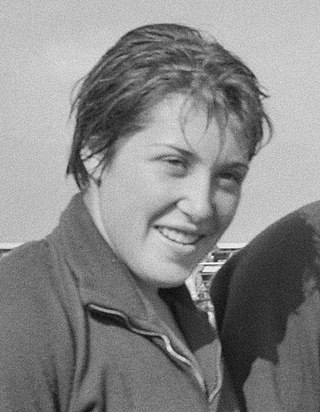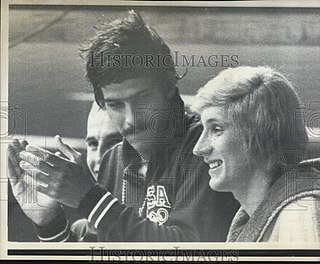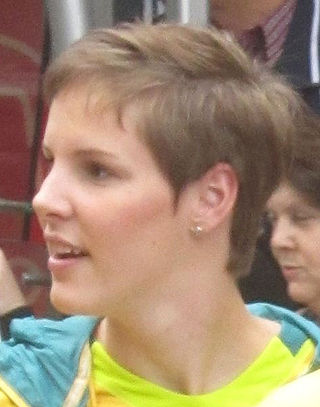
Swimming has been a sport at every modern Summer Olympics. It has been open to women since 1912. At the Olympics, swimming has the second-highest number of medal-contested events.

Sandra Anne Morgan, also known by her married name Sandra Beavis, or as Sandra Morgan-Beavis, is an Australian former freestyle swimmer who was part of the gold medal-winning team in the 4×100-metre freestyle relay at the 1956 Summer Olympics in Melbourne. At the age of 14 years and 6 months, she became the youngest Australian to win an Olympic gold medal, a record that still stands.
The women's 4 × 100 metre medley relay event at the 1964 Olympic Games took place on 16 October (qualification) and 18 October (final). This swimming event uses medley swimming as a relay. Because an Olympic size swimming pool is 50 metres long, each of the four swimmers completed two lengths of the pool, each using a different stroke. The first on each team used the backstroke, the second used the breaststroke, the third used the butterfly stroke, and the final swimmer used freestyle.
The women's 4 × 100 metre freestyle relay event at the 1948 Olympic Games took place on 4 and 6 August at the Empire Pool. This swimming event used freestyle as a relay, with swimmers typically using the front crawl. Because an Olympic size swimming pool is 50 metres long, each of the four swimmers completed two lengths of the pool. The first swimmer had to touch the wall before the second could leave the starting block; timing of the starts was thus important.
The women's 100 metre freestyle event at the 1952 Olympic Games took place between 26 and 28 July at the Swimming Stadium. This swimming event used freestyle swimming, which means that the method of the stroke is not regulated. Nearly all swimmers use the front crawl or a variant of that stroke. Because an Olympic size swimming pool is 50 metres long, this race consisted of two lengths of the pool.

The women's 4 × 100 metre freestyle relay event at the 1956 Olympic Games took place on 4 and 6 December. This swimming event used freestyle as a relay, with swimmers typically using the front crawl. Because an Olympic size swimming pool is 50 metres long, each of the four swimmers completed two lengths of the pool. The first swimmer had to touch the wall before the second could leave the starting block; timing of the starts was thus important.
The women's 4 × 100 metre freestyle relay event at the 1960 Olympic Games took place on September 2 and 3, in Rome. This swimming event used freestyle as a relay, with swimmers typically using the front crawl. Because an Olympic size swimming pool is 50 metres long, each of the four swimmers completed two lengths of the pool. The first swimmer had to touch the wall before the second could leave the starting block; timing of the starts was thus important.
The women's 4 × 100 metre medley relay event at the 1960 Olympic Games took place on August 30 (qualification) and September 2 (final). This swimming event uses medley swimming as a relay. Because an Olympic size swimming pool is 50 metres long, each of the four swimmers completed two lengths of the pool, each using a different stroke. The first on each team used the backstroke, the second used the breaststroke, the third used the butterfly stroke, and the final swimmer used freestyle.
The men's 4 × 100 metre medley relay event at the 1964 Olympic Games took place on October 15 (qualification) and October 16 (final). This swimming event uses medley swimming as a relay. Because an Olympic size swimming pool is 50 metres long, each of the four swimmers completed two lengths of the pool, each using a different stroke. The first on each team used the backstroke, the second used the breaststroke, the third used the butterfly stroke, and the final swimmer used freestyle.

The men's 200 metre freestyle event at the 1968 Olympic Games took place on 24 October at the Alberca Olímpica Francisco Márquez. It was the third time the event was held, returning for the first time since 1904. There were 57 competitors from 26 nations, with each nation having up to three swimmers. The event was won by Michael Wenden of Australia, the nation's second victory in the event ; Australia extended its podium streak in the event to three Games over 68 years. It was Wenden's second gold medal of the Games, completing a 100/200 free double. Americans Don Schollander and John Nelson took silver and bronze, respectively.
The men's 4×100 metre medley relay event at the 1968 Olympic Games took place on October 26. This swimming event uses medley swimming as a relay. Because an Olympic size swimming pool is 50 metres long, each of the four swimmers completed two lengths of the pool, each using a different stroke. The first on each team used the backstroke, the second used the breaststroke, the third used the butterfly stroke, and the final swimmer used freestyle.
The women's 4×100 metre freestyle relay event at the 1968 Olympic Games took place October 26. The relay featured teams of four swimmers each swimming two lengths of the 50 m pool freestyle.
The women's 4×100 metre medley relay event at the 1968 Olympic Games took place on 17 October. This swimming event uses medley swimming as a relay. Because an Olympic size swimming pool is 50 metres long, each of the four swimmers completed two lengths of the pool, each using a different stroke. The first on each team used the backstroke, the second used the breaststroke, the third used the butterfly stroke, and the final swimmer used freestyle.

The men's 100 metre freestyle event at the 1972 Olympic Games took place between September 2 and 3. There were 48 competitors from 29 nations. Nations had been limited to three swimmers each since the 1924 Games. The event was won by Mark Spitz of the United States, his then-record sixth gold medal in a single Games. It was the ninth victory in the event for an American, most of any nation. Jerry Heidenreich, also of the United States, took silver. Soviet swimmer Vladimir Bure earned bronze, the nation's first medal in the men's 100 metre freestyle.

The men's 200 metre freestyle event at the 1972 Summer Olympics took place on August 29 at the Olympia Schwimmhalle. There were 46 competitors from 27 nations, with each nation having up to three swimmers. The event was won by Mark Spitz of the United States, the nation's second victory in the event. It was the third gold medal for Spitz in 1972, halfway to his goal of six. His teammate Steve Genter took silver, with Werner Lampe of West Germany earning bronze. Defending champion Michael Wenden of Australia finished fourth.
The men's 4 × 100 metre medley relay event at the 1972 Olympic Games took place on September 4. This swimming event uses medley swimming as a relay. Because an Olympic size swimming pool is 50 metres long, each of the four swimmers completed two lengths of the pool, each using a different stroke. The first on each team used the backstroke, the second used the breaststroke, the third used the butterfly stroke, and the final swimmer used freestyle.
The women's 4 × 100 metre freestyle relay event at the 1972 Olympic Games took place August 30. The relay featured teams of four swimmers each swimming two lengths of the 50 m pool freestyle.
The women's 4 × 100 metre medley relay event at the 1972 Olympic Games took place on September 3. This swimming event uses medley swimming as a relay. Because an Olympic size swimming pool is 50 metres long, each of the four swimmers completed two lengths of the pool, each using a different stroke. The first on each team used the backstroke, the second used the breaststroke, the third used the butterfly stroke, and the final swimmer used freestyle.

Bronte Campbell is a Malawian-born Australian competitive swimmer, a dual Olympic gold-medal winner and world champion. Her older sister, Cate, is also a competitive swimmer, and once held world records in both the short and long course 100 metre individual freestyle events. Bronte and Cate are the first Australian siblings on the same Olympic swimming team since the 1972 Olympics and the first Australian sisters ever to compete within the same swimming event at the Olympics. Bronte Campbell won three gold medals at the 2015 World Championships, including the 50 and 100 metre freestyle events.
Freya Ann Alexandra Anderson is a British swimmer, known primarily for her achievements as a freestyle sprinter, especially as a relay swimmer for Great Britain. Anderson achieved nine relay gold medals at three editions of the European Championships, including 5 golds in a single meet at the 2020 European Championships in Budapest, as well as two bronze medals at the Commonwealth Games and a bronze at the 2019 World Aquatics Championships. In July 2021, she won gold as part of the British team at the 2020 Tokyo Olympics in mixed 4 × 100 metre medley relay, swimming the freestyle anchor leg in the heat.







